#Smart Textile market share
Text
Smart Textile Industry Analysis by Recent Developments and Business Outlook 2022-2027
Smart Textile Industry Analysis by Recent Developments and Business Outlook 2022-2027
Smart textile market is expected to reach US$ 13.63 Bn in 2027, by registering a CAGR of 26.1% during the forecast period 2019-2027.
Smart Textiles are designed and manufactured with the integration of smart technologies to offer fabric with different functionality. These textiles are used across numerous applications and offer better communication with other devices, generate electricity,…
View On WordPress
#Smart Textile market#Smart Textile market analysis#Smart Textile market growth#Smart Textile market share#Smart Textile market size
0 notes
Quote
The Global Smart Textiles market was valued at USD 2.20 billion in 2021 and is expected to reach USD 8.85 billion by the year 2028, at a CAGR of 22%.
Smart Textiles Market- In Deep Analysis Focusing on Market Share And Growth Rate (2022- 2028) | IMR
0 notes
Text
The Business Research Company offers smart textiles market research report 2023 with industry size, share, segments and market growth
#smart textiles market outlook#smart textiles market research#smart textiles market trends#smart textiles industry share#smart textiles market segments#smart textiles market analysis#global smart textiles market#smart textiles market report#smart textiles market#smart textiles market growth#smart textiles market forecast#smart textiles market size#smart textiles industry
0 notes
Text
Smart Textile Market Scope and overview, To Develop with Increased Global Emphasis on Industrialization 2030| By R&I
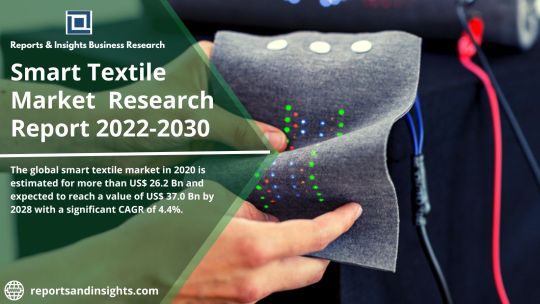
The report is titled as ‘Smart Textile Market: Opportunity Analysis and Future Assessment 2020-2028’. An overview of conceptual frameworks, analytical approaches of the smart textile market is the main objective of the report, which further consists the market opportunity and insights of the data involved in the making of the respective market. The smart textile market is expected to grow with significant rate in the near future.
The global smart textile market in 2020 is estimated for more than US$ 26.2 Bn and expected to reach a value of US$ 37.0 Bn by 2028 with a significant CAGR of 4.4%.
Request a Sample Copy of this Report @: https://reportsandinsights.com/sample-request/1250
Smart Textile Introduction
Basically, a textile is a product shaped and created by weaving yarns or threads into fabric. In the first place, the weaving threads were obtained from plant-based or natural animal fibers. Then as time passed, technology upgraded and modernized, and synthetic fibers replaced the natural fibers as they were stronger, durable, and flexible.
And now, in the present-day world, the advent of programmed communications technology has reached the point where the intensely thin fibers that run through advanced devices such as smartphones and communicate data can be intertwined into cloth textiles. Ultimately, this is what is known as a smart textile comprising a cloth that has advanced computer-based technology interwoven into it.
Smart textiles are the fabric that allows the wearer to involve digital appliances and functions to be equipped in them. The smart textiles are designed with technologically advanced and innovative methods that have the potential to add value and allow the wearer to oversee the movements and several other applications.
Moreover, smart textiles also have the capability to change their color or utilize energy. Owing to which, smart textiles are projected to witness significant demand in the near future.
Smart Textile Market Dynamics
The constantly advancing technology in present times and penetration of modernized technology in various industries has resulted in the development of smart textiles that comprises an advanced computer-based technology woven into it.
Along with that, there has been huge demand among the population for smart technology such as smartphones, smart wrist-watches, and other devices, which is also acting as a positive factor that is expected to fuel the growth of the global smart textiles market in the near future.
In addition to that, smart textiles have an exhilarating demand in several different industries such as in military & defense applications, the healthcare sector, and the sports sector, which further propels the growth of the global smart textiles market.
Apart from that, the unification of principles of nanotechnology in the textile industry is also one of the key factors that are estimated to give a positive boost to the growth of the global smart textiles market during the forecast timeframe.
Furthermore, the growing demand for the miniaturization of electronic elements as well as sophisticated gadgets is also expected to accelerate the growth of the global smart textiles market in the near future. Although the enormous cost of production and no collaborations between market players may restrict the growth of the global smart textiles market in the coming years.
MMC Overview on Smart Textile Market Report
The non-identical approach of Reports and Insights stands with conceptual methods backed up with the data analysis. The novel market understanding approach makes up the standard of the assessment results that give better opportunity for the customers to put their effort.
A research report on the Smart Textile market by Reports and Insights is an in-depth and extensive study of the market based on the necessary data crunching and statistical analysis. It provides a brief view of the dynamics flowing through the market, which includes the factors that support the market and the factors that are acting as impedance for the growth of the market.
Furthermore, the report includes the various trends and opportunities in the respective market in different regions for a better understanding of readers that helps to analyze the potential of the market.
Wish to Know More About the Study? Click here to get a Report Description: https://reportsandinsights.com/pressrelease/global-smart-textiles-market
Smart Textile Market Segmentation
The smart textile market is segmented on the basis of function, type, end-user industry, and region.
By Function
Sensing
Energy Harvesting
Luminescence & Aesthetics
Thermo-electricity
Others
By Type
Passive Smart
Active Smart
Ultra-Smart
By End-User Industry
Military and Protection
Architecture
Healthcare
Sports and fitness
Fashion and entertainment
Automotive
Others
By Region
North America
Latin America
Europe
Asia Pacific
Middle East
Africa
Smart Textile Market Key Players
Some of the key participating players in the smart textile market are:
Google Inc.
Intelligent Clothing Ltd.
International Fashion Machines, Inc.
Interactive Wear AG
Schoeller Textiles AG
Textronics, Inc.
Vista Medical Ltd.
Gentherm Incorporated
Sensoria Inc.
To view Top Players, Segmentation and other Statistics of Smart Textile Industry, Get Sample Report @: https://reportsandinsights.com/sample-request/1250
About Reports and Insights:
Reports and Insights is one of the leading market research companies which offers syndicate and consulting research around the globe. At Reports and Insights, we adhere to the client needs and regularly ponder to bring out more valuable and real outcomes for our customers. We are equipped with strategically enhanced group of researchers and analysts that redefines and stabilizes the business polarity in different categorical dimensions of the market.
Contact Us:
Neil Jonathan
1820 Avenue M, Brooklyn
NY 11230, United States
+1-(718) 312-8686
Find Us on LinkedIn: www.linkedin.com/company/report-and-insights/
View Latest Market Updates At: https://marketsresearchanalytics.com
#Smart Textile Market Research#Smart Textile Market Report#Smart Textile Market Share 2021#Smart Textile Market Size 2022#Smart Textile Market Trends#Smart Textile Market Key Players#Global Smart Textile Market Analysis#Smart Textile Industry News#Smart Textile Industry Analysis#Smart Textile Market Forecast#Smart Textile Market CAGR#USA Smart Textile Market#Japan Smart Textile Market#Smart Textile Market Demand#Argentina Smart Textile Market#Australia Smart Textile Market#Belgium Smart Textile Market#Brazil Smart Textile Market#Canada Smart Textile Market#Chile Smart Textile Market#China Smart Textile Market#Columbia Smart Textile Market#Egypt Smart Textile Market#France Smart Textile Market#Germany Smart Textile Market#Global Smart Textile Market#India Smart Textile Market#Indonesia Smart Textile Market#Smart Textile Applications#Smart Textile Industry
0 notes
Text
Global Smart Textiles Size And Growth Analysis The Global Smart Textiles 2022.

These very performing impart these textiles the names such as Smart Textiles, e-textiles (electronic textiles), intelligent textiles, or Functional Fabrics. Additionally, smart textiles use heat, electrical, chemical, magnetic, or other detection systems to sense electrical, magnetic, thermal, mechanical, temperature, or chemical changes in the environment. Moreover, smart textiles are anticipated to highly benefit from the gaining popularity and incorporation of electronic wearables.
Read more: https://introspectivemarketresearch.com/reports/smart-textiles-market/
#Global Smart Textiles Market#Global Smart Textiles Market share#Global Smart Textiles Market size#Global Smart Textiles Marketgrowth
0 notes
Link
Smart Textiles For Military Market is poised to grow at a CAGR of 15 % by 2027. Factors driving the Smart Textiles For Military Market are military powerhouses investing in soldier modernization and in the R&D.
#smart textiles for military market#smart textiles for military market size#smart textiles for military market revenue#smart textiles for military market analysis#smart textiles for military market share#smart textiles for military market trends#smart textiles for military industry
0 notes
Text
Smart Textiles Recent Trends -2022
Market Insights:
The Global Market for Smart Textiles projected at US$1.8 Billion in the year 2020, is estimated to gain a revised size of US$5.9 Billion by 2026, growing at a CAGR of 22% during the forecasting period 2021- 2027.
IMR are forces that impact the prices and behaviors of the Global Smart Textiles Market stakeholders. These forces create pricing signals which result from the changes in the supply and demand curves for a given product or service. IMR may be related to macro-economic and micro-economic factors. There are dynamic market forces other than price, demand, and supply. Human emotions can also drive decisions, influence the market, and create price signals. As the market dynamics impact the supply and demand curves, decision-makers aim to determine the best way to use various financial tools to stem various strategies for speeding the growth and reducing the risks.
Request a Free Sample of Smart Textiles Market Report:
https://introspectivemarketresearch.com/request/15908
Textiles are referred to as any item that is being developed by fibers or threads into fabric. It is mainly manufactured from natural fibers, animal or vegetable origin. With time and technological developments, textiles have developed from being a simple piece of cloth or fabric to something that can be functional, beautiful, and responsive all at the same time. These very performing impart these textiles the names such as Smart Textiles, e-textiles (electronic textiles), intelligent textiles, or Functional Fabrics. Additionally, smart textiles use heat, electrical, chemical, magnetic, or other detection systems to sense electrical, magnetic, thermal, mechanical, temperature, or chemical changes in the environment. Moreover, smart textiles are anticipated to highly benefit from the gaining popularity and incorporation of electronic wearables.
The key players covered in the Smart Textiles market report is:
Adidas AG (Germany),DuPont de Nemours Inc.(US),Alphabet (US),International Fashion Machines Inc.(U.S.),Jabil (US),Texas Instruments Incorporated. (US),Sensoria Inc. (U.S.),Intelligent Clothing Ltd. (U.K.),Schoeller Textiles AG (Switzerland),Interactive Wear AG (Germany),Ohmatex A/S (Denmark),Textronics,Design Systems (I) Pvt. Ltd. (U.S.),Google Inc. (U.S.),Vista Medical Ltd. (Canada),Gentherm Incorporated (U.S.),AIQ Smart Clothing (Taiwan),Outlast Technologies (US),Hexoskin (Canada)
Segmentation of Smart Textiles market:
In market segmentation by Type, Smart Textiles Market report covers:
Passive,Active/Ultra-smart
In market segmentation by Applications , Smart Textiles Market report covers:
Military & Defense,Healthcare,Entertainment,Automotive,Sports & Fitness,Other Applications
Market Segment by Regions and Countries Level Analysis:
· North America (U.S., Canada, Mexico)
· Europe (Germany, U.K., France, Italy, Russia, Spain, Rest of Europe)
· Asia-Pacific (China, India, Japan, Southeast Asia, Rest of APAC)
· Middle East & Africa (GCC Countries, South Africa, Rest of MEA)
· South America (Brazil, Argentina, Rest of South America)
If You Have Any Query Smart Textiles Market Report, Visit:
https://introspectivemarketresearch.com/inquiry/15908
Recent trends and developments in the global Smart Textiles market have been analyzed. Opportunities leading to the growth of the market have been analyzed and stated. Drivers and restraints impacting the growth of the market have also been analyzed. A segmentation of the global Smart market has been done for the purpose of a detailed study. The market is segmented on the basis of key criteria. Data on the leading and fastest-growing segments along with what drives them has been given. This report implements a balanced mix of primary and secondary research methodologies for its analysis.
Scope and Segmentation Of The Smart Textiles Market Research Report
Report Coverage
Details
Forecast Period
2022 to 2028
Forecast Period 2022 to 2028 CAGR
22%
2026 Value Projection
USD 5.9 Billion
Base Year
2021
Reasons to buy the global Smart Textiles market
1. This research identifies the region and market sector that is likely to expand the fastest and dominate the Smart Textiles industry.
2. Market analysis of the Smart Textiles by region, covering the consumption of the manufacturer in each country as well as the factors that influence the market within each region.
3. The market environment includes the top players’ Smart Textiles market rankings, as well as new service/product announcements, collaborations, company growth, and acquisitions made by the companies profiled in the previous five years.
4. For the top Smart Textiles market players, extensive company profiles with business overviews, company insights, product evaluations, and SWOT analyses are available.
5. The company’s present and future outlook in light of recent changes (which include both advanced and developing regions’ growth possibilities and drivers, as well as difficulties and restraints).
READ MORE PR:
· https://introspectivemarketresearch.com/press-release/foot-care-products-market-to-reach-3.82-billion-by-2028/
· https://introspectivemarketresearch.com/press-release/fresh-cherries-market-to-reach-92.80-usd-billion-by-2028/
0 notes
Text
Moscow's Lower Presnya - factory workers' village built in late 1920s
Thank you for making it happen: K. T., H. W., T. B., m., @depetium, @transarkadydzyubin, S. R.
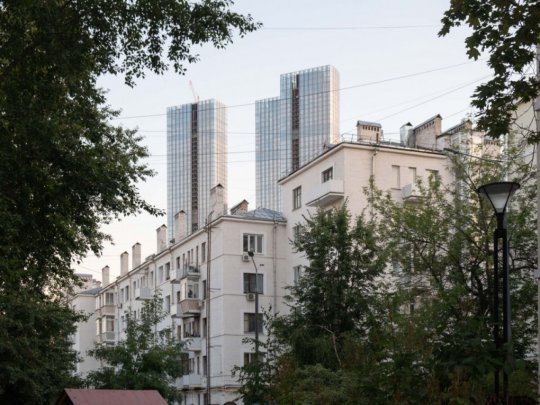
Presnya in Moscow was a district of factories since the 18th century. Some of the factories that were based here are the Prokhorov's textile factory (Tryokhgornaya Manufactura), Smith's boiler factory, Danilovsky sugar factory, Ossovetsky's chemical plants etc. Factory workers usually lived close by (some of the factory owners built housing, but not all) so there were a wide array of houses and buildings (some brick, some wooden). After the 1917 Revolution all of the factories were nationalised and workers' living situation rethinked.
Presnya was the first workers' village in Moscow rebuilt after the Revolution (began in 1926). Emerged a district of 4-floor brick houses in formations that created court yards (something that didn't really exist for apartment buildings before then). Court yards were there purely for comfort of the residents. The new buildings mostly consisted of standard sections of 2 or 4 flats per floor per entrance. The standartisation helped bring the costs down (the buildings themselves were all still different). Buildings stood far enough from each other to allow enough air and sunlight. Most of the flats had windows facing North and South - it helped with air flow and sanitation (tuberculosis and other diseases were on the rise, and having direct sunlight in the flat was detrimental for germs). Many of the flats (though not all) had kitchens and bathrooms. Every building had a built-in boiler room that provided heating in winter. Flats were equipped with their own boilers to cook and heat water. Some other "smart house" solutions in the flats: a pipe system that sent heated water from the kitched to the bathroom, oven-samovar connector (to simplify boiling a samovar), built-in "ice pantry" in the kitchen (served as a fridge in wintertime), air ducts in every room, floor air ducts that also served as water retractors and prevented flooding the neighbours downstairs.
It's important to note that while some families had a whole flat to themselves, most of them were kommunalkas [communal flats] with several families sharing one flat, one room per family. Typically, workers aged 40+ with big families were more likely to get their own flat that younger or unmarried workers.
Let's see some of the residential buildings!
First, some of the 19th century ones - originally built by factory owners as housing for workers.
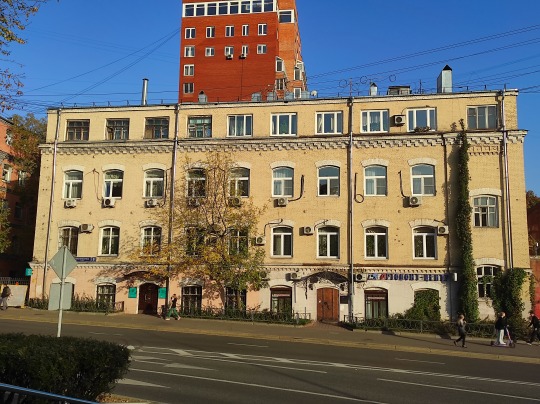

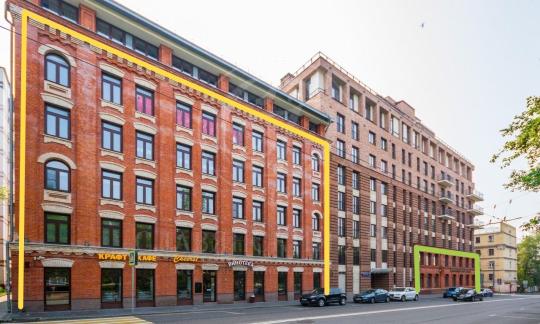
This new elite residence is built over three 19th cent. buildings. They tried to save as much as possible. The building on the left is mostly as is (only an extra floor was added on top), the building on the far right was kept as part of the facade, and the middle one was in too bad a condition to save, unfortunately.


Corner house with the Kommunar store - designed by Aleksandr Kurovsky.

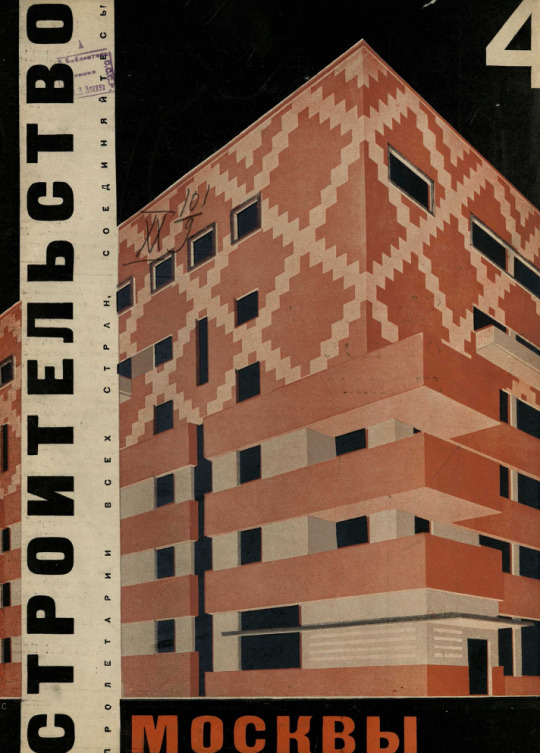
Another building designed by Kurovsky was initially supposed to have more balconies - see the project on the cover of Building Moscow (#4, 1929). Originally the colors were reversed: the building was made of red brick (befitting the red brick factory surroundings) and the patterns were made of lime brick.


Pair of buildings designed by engineer Osvald Kapran are very simple but have a distinct feature.


And finally the architectural dominant of the Lower Presnya - Mostorg [Moscow Trade] department store designed by Brothers Vesnin and built in 1928. It was their first constructivist building in Moscow. This was the first and only store of this magnitute in the district, a symbol of the new centralised trade as opposed to old style markets.
Part one - Architecture | Part two - Museum
74 notes
·
View notes
Text
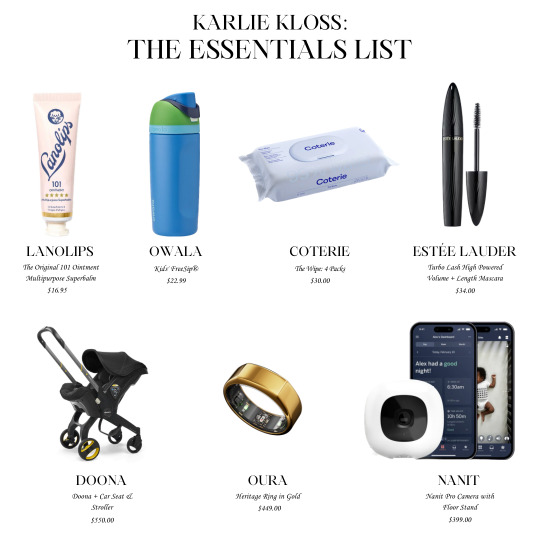
karlie kloss recently shared some of her parenting and everyday must-haves with cnn underscored!
1. Lanolips, “The Original 101 Ointment Multipurpose Superbalm” - $16.95
"I use this balm every single day," Kloss says. "It keeps my lips and skin hydrated 24/7." Made 100% naturally with ultra-pure grade Australian lanolin, the 101 Ointment is aptly named: it serves 101 functions. This balm is excellent for anything dry or chapped including lips, skin patches, cuticles, elbows, and more. It is also safe to use during pregnancy, for nursing mothers, and with babies
2. Owala, “Kids’ Freesip” - $22.99
"Levi adores his colorful sippy cup, and it never, ever leaks," Kloss says. Made from triple-layered, vacuum-insulated stainless steel, the FreeSip is not only tough but also keeps drinks cold for up to 24 hours.
3. Coterie, “The Wipe: 4 Pack” - $30.00
"As a professional model, l've spent many hours on a makeup chair, so i've been through my fair share of makeup and baby wipes," Kloss says. "These ones from Coterie are my favorite! They're great for diaper changes, sticky hands and faces or any other daily messes. I even use them on myself, and I will be carrying them in my bag long after I have a child in diapers!" Up to 30% larger than most wipes, Coterie’s are chemical-free and made with purified water, skincare ingredients such as vitamin E and glycerin, and plant-based, plastic-free, biodegradable fibers.
4. Estée Lauder, “Turbo Lash High Powered Volume + Length Mascara” - $34.00
Kloss, who is an Estée Lauder global brand ambassador, says, "When I'm not working, I prefer to go for a more natural look, and this mascara is one of my staples for my daily routine. It gives my lashes that perfect lift for an easy, effortless look."
5. Doona, “Doona + Car Seat & Stroller” - $550
"I love this stroller because it's very new-parent-friendly and easy to fold, which really comes in handy when you're strapped for time and on the move," Kloss says. As the first fully integrated travel system, Doona’s car seat allows for travel with ease for parents on-the-go as it can transform into a stroller within seconds. Available in seven colors, the Doona includes a five-point harness, an adjustable handlebar, and removable and washable textiles.
6. Oura, “Heritage Ring in Gold” - $449
"I swear by the Oura Ring," Kloss says. "It helps track my sleep every day, giving me all the data I need to help improve my sleep quality so that I feel my very best the next morning." The Oura can track everything from sleep and fitness to stress and general health, all available to track and monitor on the brand’s app.
7. Nanit, “Nanit Pro Camera with Floor Stand” - $399.00
"I'm such a tech nerd, and this smart baby monitor is one of the best on the market," Kloss says. "It comes with its own app, so you can take a peek whenever, and it really does help take some of that stress away." Delivering 1080p HD video, the Nanit comes with built-in sound and motion alerts and has a split-screen feature that allows users to view and control two cameras at once.
you can read the article here
3 notes
·
View notes
Text
Bioplastics Market Share, Size, Global Driving Factors by Manufacturers, Growth Opportunities
The global bioplastics market size was USD 10.64 Billion in 2021 and is expected to register a revenue CAGR of 16.8% over the forecast period, according to the latest analysis by Emergen Research. Increase in demand for bioplastics from the automotive industry and demand for compostable plastics to improve soil quality are factors expected to support revenue growth of the market between 2022 and 2030. The automotive industry's primary objective and challenge is to reduce fuel consumption and pollutants by reducing vehicle weight. Bioplastics are effective materials for achieving this purpose. These smart plastics, such as bio-PA and bio-PP, have been embraced by major vehicle manufacturers to reduce environmental impact and provide additional strength to automobile components. Thus, demand for these plastics in the automotive industry owing to their excellent properties is anticipated to create lucrative growth prospects for companies in the market.
Get a sample of the Bioplastics Market report @ https://www.emergenresearch.com/request-sample/169
The global Bioplastics market report covers the analysis of drivers, trends, limitations, restraints, and challenges arising in the Bioplastics market. The report also discusses the impact of various other market factors affecting the growth of the market across various segments and regions. The report segments the market on the basis of types, applications, and regions to impart a better understanding of the Bioplastics market.
Emergen Research has segmented the global Bioplastics market on the basis of type, platform, application, and region:
Type Outlook (Revenue, USD Billion; 2017-2027)
Biodegradable
Polybutylene Adipate Terephthalate (PBAT)
Polybutylene Succinate (PBS)
Polylactic Acid (PLA)
Polyhydroxyalkanoate (PHA)
Starch Blends
Others
Distribution Channel Outlook (Revenue, USD Billion; 2017-2027)
Online
Offline
Application Outlook (Revenue, USD Billion; 2017-2027)
Packaging
Textile
Automotive & Transportation
Consumer Goods
Agriculture
Building & Construction
Others
Request a discount on the Bioplastics Market report @ https://www.emergenresearch.com/request-discount/169
Based on the competitive landscape, the market report analyzes the key companies operating in the industry:
BASF SE, NatureWorks, Biome Plastics, Braskem, Biotec, Total Corbion, Plantic Technologies, Mitsubishi Chemical Holdings Corporation, Novamont SPA, and Toray Industries
Additionally, the report covers the analysis of the key players in the industry with a special focus on their global position, financial status, and their recent developments. Porter’s Five Forces Analysis and SWOT analysis have been covered by the report to provide relevant data on the competitive landscape.
How will this Report Benefit you?
An Emergen Research report of 250 pages contains 194 tables, 189 charts and graphics, and anyone who needs a comprehensive analysis of the global Bioplastics market, as well as commercial, in-depth analyses of the individual segments, will find the study useful. Our recent study allows you to assess the entire regional and global market for Bioplastics. In order to increase market share, obtain financial analysis of each segment and the whole market. Look at how you can utilize the current and potential revenue-generating opportunities available in this sector. We believe that there are significant prospects for energy storage technology in this industry due to the rapid expansion of the technology. In addition to helping you build growth strategies, improve competitor analysis, and increase business productivity, the research will also assist you in making better strategic decisions.
Detailed Regional Analysis covers:
North America (U.S., Canada)
Europe (U.K., Italy, Germany, France, Rest of EU)
Asia-Pacific (India, Japan, China, South Korea, Australia, Rest of APAC)
Latin America (Chile, Brazil, Argentina, Rest of Latin America)
Middle East & Africa (Saudi Arabia, U.A.E., South Africa, Rest of MEA)
To Study Full Bioplastics Market Report, click here @ https://www.emergenresearch.com/industry-report/bioplastics-market
What Questions Should You Ask before Buying a Market Research Report?
How is the Bioplastics market evolving?
What is driving and restraining the Bioplastics market?
How will each Bioplastics submarket segment grow over the forecast period and how much revenue will these submarkets account for in 2027?
How will the market shares for each Bioplastics submarket develop from 2020 to 2027?
What will be the main driver for the overall market from 2020 to 2027?
Will leading Bioplastics markets broadly follow the macroeconomic dynamics, or will individual national markets outperform others?
How will the market shares of the national markets change by 2027 and which geographical region will lead the market in 2027?
Who are the leading players and what are their prospects over the forecast period?
What are the Bioplastics projects for these leading companies?
How will the industry evolve during the period between 2020 and 2027? What are the implications of Bioplastics projects taking place now and over the next 10 years?
Is there a greater need for product commercialisation to further scale the Bioplastics market?
Where is the Bioplastics market heading and how can you ensure you are at the forefront of the market?
What are the best investment options for new product and service lines?
What are the key prospects for moving companies into a new growth path and C-suite?
Request customization on the report @ https://www.emergenresearch.com/request-for-customization/169
Thank you for reading our report. To know more about the customization of the report, please get in touch with us, and our team will ensure the report is suited to your requirements.
About Us:
Emergen Research is a market research and consulting company that provides syndicated research reports, customized research reports, and consulting services. Our solutions purely focus on your purpose to locate, target, and analyse consumer behavior shifts across demographics, across industries, and help clients make smarter business decisions. We offer market intelligence studies ensuring relevant and fact-based research across multiple industries, including Healthcare, Touch Points, Chemicals, Types, and Energy. We consistently update our research offerings to ensure our clients are aware of the latest trends existent in the market. Emergen Research has a strong base of experienced analysts from varied areas of expertise. Our industry experience and ability to develop a concrete solution to any research problems provides our clients with the ability to secure an edge over their respective competitors.
For More Related Reports by Emergen Research
gambling software market: https://www.emergenresearch.com/industry-report/gambling-software-market
functional ingredients market: https://www.emergenresearch.com/industry-report/functional-ingredients-market
space mining market: https://www.emergenresearch.com/industry-report/space-mining-market
acrylic resins market: https://www.emergenresearch.com/industry-report/acrylic-resins-market
drone logistics and transportation market: https://www.emergenresearch.com/industry-report/drone-logistics-and-transportation-market
targeted therapeutics market: https://www.emergenresearch.com/industry-report/targeted-therapeutics-market
airborne intelligence surveillance and reconnaissance market: https://www.emergenresearch.com/industry-report/airborne-intelligence-surveillance-and-reconnaissance-market
small caliber ammunition market: https://www.emergenresearch.com/industry-report/small-caliber-ammunition-market
1 note
·
View note
Text
Water Quality Monitoring Market: IoT & Tech Prospects

With the rising population, climate crisis, and increasing pollution levels, ensuring the availability of safe water has become a major concern. Routine assessment of water quality is thus crucial, and water quality monitoring (WQM) systems have been immensely beneficial in this regard. As a result, their adoption has significantly increased in recent years, driving the growth of the global water quality monitoring market.
Experts at Triton Market Research estimate this market to grow with a CAGR of 5.51% in the forecast years between 2023 and 2030, reaching a revenue of $8275.72 million by 2030. Earlier, monitoring was conducted using manual, costly, and time-consuming laboratory-based testing techniques. However, the development of fully integrated and reliable WQM systems has largely optimized this process as they provide real-time data and insights. This has widened the market’s growth prospects worldwide.
How are Developed and Developing Markets Leveraging WQM Systems?
Several governments in Europe have implemented stringent regulations to safeguard water bodies in the region. The increased emphasis on promoting sustainable water usage, preventing & reducing pollution, and protecting & improving the aquatic ecosystem has largely enhanced the adoption of water quality monitoring devices and systems across the European market.
Major players from the chemical, textile, beauty & cosmetics, and automotive industries are shifting their manufacturing and industrial facilities from developed nations to developing ones. With this, the carbon emission levels and industrial waste generation have also risen. Moreover, the regulations pertaining to wastewater disposal in these countries are not as stringent as those in developed economies.
The serious health issues caused by consuming contaminated water have necessitated the adoption of WQM systems. Thus, the studied market shows immense scope for expansion in the Asian, African, and Latin American regions. In fact, the Latin America water quality monitoring market is anticipated to progress with the fastest CAGR of 7.42% during the forecasted period.
pH Sensors – Their Utility, Demand, and Prospects
One of the causes of waterborne diseases is the consumption of water that is highly acidic or alkaline in nature, as it can disrupt the body’s balance. Thus, measuring its pH levels is important. While this was traditionally done using pH indicators, sensor technology advancements have enabled more accurate assessment with the development of pH sensors.
pH sensors dominates the component segment. It held the highest revenue share of $1705.72 million in 2022, and is likely to grow with the fastest CAGR of 5.83% during 2023-2030.
Using its patented technology, Emerson Electric Co has developed the Rosemount 550 single-use pH sensor; it has a two-year shelf life, and is incorporated with immediate sensor verification and calibration features, which eliminates the need for initial stabilization. Besides, Xylem Inc and Thermo Fisher Scientific Inc are also renowned for their cutting-edge pH sensors and analyzers.
Product launches by market players, government regulations on water-intensive industries, and the damaging effects of acidic or basic water on pipelines & other equipment have surged the demand for these sensors. The above-mentioned factors, along with the high applicability of the sensors across various industries, contribute to the growth of the global pH sensors & analyzers market.
IoT Integration – Facilitating the Shift towards Smart Water Quality Monitoring
Even though the currently used wireless sensor network-based water monitoring systems have undergone technological advancements over the years, they come with their share of problems. However, the integration of the Internet of Things (IoT) in them has facilitated smart water quality monitoring, by ensuring greater efficiency, security, and cost-effectiveness, along with providing real-time data.
IoT allows smart devices to conveniently store and exchange data, and thus, this technology has found its applications in environmental monitoring. One of its benefits is that IoT-enabled WQM systems help treat wastewater before it is released into freshwater bodies.
Every year, millions of gallons of water are wasted due to leaks, meter errors, and other operational inefficiencies. IoT-based water flow sensors are useful for spotting leakages and other malfunctions immediately by analyzing the flow through pipes. This helps curb the problem before it results in high bills for commercial and residential end-users.
Realizing this growth opportunity, Scotland-based M2M Cloud is working towards enhancing its existing Neptune water monitoring device’s capabilities by incorporating IoT, as part of a $156,247 project, in association with CENSIS. This is indicative of the fact that tech integration and innovation are key for players to sustain and thrive in the water quality monitoring market.
FAQs:
Q 1) What factor restricts the global market’s growth?
The high cost of WQM systems majorly hinders their adoption, thus restricting the market growth.
Q 2) Which are the various applications studied in the market report?
Industrial, Commercial, Utilities, Residential, and Other Applications are studied in the market report.
Q 3) Which region leads the global WQM market?
With the highest revenue of $2220.46 million in 2022, North America leads the global market.
0 notes
Text
0 notes
Link
#Ahmedabadattractions#Ahmedabadsightseeing#CulturalheritageofAhmedabad#HistoricalsitesinAhmedabad#ThingstoseeinAhmedabad
0 notes
Text
Smart Textile Market Global Trends Forecast by 2031

The Insight Partners market research Smart Textile Market Size and Share Report | 2031 is now available for purchase. This report offers an exclusive evaluation of a range of business environment factors impacting market participants. The market information included in this report is assimilated and reliant on a few strategies, for example, PESTLE, Porter's Five, SWOT examination, and market dynamics
Smart Textile market is evaluated based on current scenarios and future projections are added keeping the projected period in consideration. This report integrates the valuation of Smart Textile market size for esteem (million USD) and volume (K Units). Research analysts have used top-down, bottom-up, primary, and secondary research approaches to evaluate and approve the Smart Textile market estimation.
Detailed scrutiny of market shares, optional sources, and basic essential sources has been done to integrate only valid facts. This research further reveals strategies to help companies grow in the Smart Textile market.
Key objectives of this research are:
To contemporary market dynamics including drivers, challenges, threats, and opportunities in the Smart Textile market.
To analyze the sum and market estimation of the worldwide Smart Textile market
Based on key facets, market segments are added.
The competitive analysis covers key market players and their business strategies.
To examine the Smart Textile Market for business probable and strategic outlook.
To review the Smart Textile Market size, key regions and countries, end-users, and statistical details.
To offer strategic recommendations based on the latest market developments, and Smart Textile market trends.
Perks of The Insight Partners’ Smart Textile Market Research
Market Trends: Our report reveals developing Smart Textile market trends that are poised to reshape the market preparing businesses with the foresight to retain their competitive edge. This Market research report presents market trends, supply chain analysis, leading participants, and business growth strategies. This research covers technological progress and key developments covering various aspects of the inclusive market. It is valuable market research for existing key players as well as new entrants in the Smart Textile Market. Through inputs derived from experts, this research attempts to guide future investors about market details and potential returns on investment.
Competitive Landscape: This research reveals key market players, their strategies, and possible areas for differentiation.
Analysts Viewpoint: We have industry-specific experts who add credibility to this report with their exclusive viewpoints based on market understanding and expertise. This report goes further into details of entire business processes and doesn’t restrict to only operational aspects. These insights cover venture economics and include tactics for capital investment, investor funding, and projections of ROIs. Net income and profit loss financial stats are crucial metrics of this Smart Textile market report. With these meticulous insights companies can reduce their risks and increase the success rate in the coming decade.
Segmental Coverage:
Type
Active
Passive
Ultra-Smart
Function
Sensing
Energy harvesting
Luminescence & Aesthetics
Thermo-Electricity
Industry Vertical
Healthcare
Sports & Fitness
Fashion
Military
Automotive
Market Leaders and Key Company Profiles:
1. Dupont 2. Jabil 3. Sensoria 4. Interactive Wear AG 5. Adidas 6. Hexoskin 7. Schoeller Textiles AG 8. Clim8 9. Nike, Inc 10. Thermosoft International
What all adds up to the credibility of this research?
A comprehensive summary of the contemporary Smart Textile market scenario
Precise estimations on market revenue forecasts and CAGR to rationalize resources
Regional coverage to uncover new markets for business
Rivalry analysis aims to help corporations at a modest edge
Facts-based crystal-clear insights for business success
The research can be customized as per business necessities
Access to PDF, and PPT formats of this research
Published by -
Rohan Gosavi
Senior Market Research Expert at The Insight Partners
#smarttextile#blog#blogpost#bloggercommunity#articles#articlewriting#articlemarketing#marketresearch#marketstrategy#industryanalysis#marketanalysis#googleblog#usablog
0 notes
Text
Medical Smart Textiles Market Insights: Key Players' Innovations and Growth Potential
The global medical smart textile market is expected to reach value of USD 2,177.6 Million in 2027, according to a latest analysis by Emergen Research. Rise in incidence of chronic diseases, advancements in diagnosis methods, and growing adoption of wearable medical devices is driving growth of the medical smart textiles market currently. Medical smart textiles have sensors integrated into them, and these fabrics are to produce gowns that can be worn by patients or persons with illness or disease. The sensors capture any physiological changes in the body and alerts are shared with healthcare professionals and staff.
The report sheds light on the mergers and acquisitions, collaborations, joint ventures, brand promotions and product launches, agreements and partnerships, and corporate and government deals. The comprehensive analysis of the competitive landscape offers the readers a deeper understanding about the competitors.
Download Free Sample Report of Global Medical Smart Textiles Market @ https://www.emergenresearch.com/request-sample/469
The study outlines the rapidly evolving and growing market segments along with valuable insights into each element of the industry. The industry has witnessed the entry of several new players, and the report aims to deliver insightful information about their transition and growth in the market. Mergers, acquisitions, partnerships, agreements, product launches, and joint ventures are all outlined in the report.
The leading market contenders listed in the report are:
AiQ Smart Clothing, Inc., Schoeller Textiles AG, Carre Technologies Inc., Vista Medical Ltd., Sensoria Inc., Siren, Camira Fabrics, Gentherm, Pireta, 3TEKS
Research Report on the Medical Smart Textiles Market Addresses the Following Key Questions:
Who are the dominant players of the Medical Smart Textiles market?
Which regional market is anticipated to have a high growth rate over the projected period?
What consumer trends and demands are expected to influence the operations of the market players in the Medical Smart Textiles market?
What are the key growth drivers and restraining factors of the Medical Smart Textiles market?
What are the expansion plans and strategic investment plans undertaken by the players to gain a robust footing in the market?
What is the overall impact of the COVID-19 pandemic on the Medical Smart Textiles market and its key segments?
Browse Full Report Description + Research Methodology + Table of Content + Infographics@ https://www.emergenresearch.com/industry-report/medical-smart-textiles-market
Emergen Research has segmented the global Medical Smart Textiles market on the basis of type, type of care, and region
Segments Covered in this report are:
Technology Outlook (Revenue, USD Million; 2020–2027)
Textile Sensors
Wearable Technology
Others
Application Outlook (Revenue, USD Million; 2020–2027)
Surgery
Bio-monitoring
Therapy and Wellness
Others
End-user Outlook (Revenue, USD Million; 2020–2027)
Hospitals and Clinics
Medical Academic and Research Center
Others
In conclusion, the Medical Smart Textiles Market report is an exhaustive database that will help readers formulate lucrative strategies. The Medical Smart Textiles Market report studies the latest economic scenario with value, drivers, constraints, growth opportunities, challenges, demand and supply ratio, production capacity, import/export status, growth rate, and others. Additionally, the report also undertakes SWOT Analysis and Porter’s Five Forces Analysis to study the leading companies.
0 notes
Text
Lint Remover Market Landscape: Trends, Drivers, and Forecast (2023-2032)
The lint remover market is projected to grow from USD 2312.79 million in 2023 to USD 3606.39 million by 2032, with a compound annual growth rate of 5.06%.
A lint remover is a device specifically designed to remove lint, which are small fibers that detach from textiles and garments during wear or washing. These fibers can accumulate on clothing, giving it a less clean and worn-out appearance. Lint removers come in various forms, including lint rollers, brushes, and shavers. They can be manual or electric, with electric models sometimes offering features like rechargeability for added convenience. Lint removers are essential for maintaining the appearance and longevity of clothing, especially for materials that are prone to pilling or gathering lint. They are widely used both in residential settings for personal clothing care and in industrial applications, such as in laundry services and the garment industry, where maintaining a lint-free fabric is crucial for quality control.
The lint remover market is currently experiencing several dynamic trends that are shaping its growth and development:
Technological Advancements: There is a strong trend toward technological innovation in lint removers, with new features that enhance convenience and effectiveness. This includes the development of portable, battery-operated devices and smart lint removers that offer automated features, catering to the growing consumer demand for easy-to-use and efficient fabric care solutions.
Eco-Friendly Solutions: Increasing consumer awareness of environmental issues is driving demand for eco-friendly lint removers. This includes products with rechargeable batteries and those made from sustainable materials, aligning with broader sustainability trends across consumer goods.
Market Expansion: Significant market growth is projected, particularly in regions like Asia Pacific, which is expected to see substantial growth due to increasing disposable incomes and urbanization. This region's market expansion is supported by the growing middle class and enhanced access to home care products via e-commerce platforms.
Competition and Innovation: The market is highly competitive with key players like Philips, 3M, and Conair continually innovating and expanding their product lines. Companies are focusing on differentiating their offerings through unique features and improved functionalities to capture a larger market share and appeal to a broad consumer base.
Key Player
Koninklijke Philips N.V.
3M Company
FLYCO
SID Superman
Conair LLC
Remington Arms Company LLC
Smartek USA Inc
Kemei Products
RIWA
Ningbo Trueman Electric Co Ltd
More About Report- https://www.credenceresearch.com/report/lint-remover-market
Competitive Analysis
The lint remover market is highly competitive and diverse, with a variety of players and products shaping the landscape. Key companies like Philips, 3M, and Conair dominate the market, focusing on product innovation and quality to maintain their lead. These companies have developed a range of products from manual lint brushes to advanced electric shavers, catering to both residential and industrial users.
The market is segmented by type (lint rollers, brushes, shavers), operation (electric, manual), and end-user (residential, industrial, including garment and laundry services). Each segment caters to specific consumer needs, from household fabric care to professional-grade applications in the garment industry. The market's growth is fueled by increasing consumer awareness of fabric care and advancements in product technology, which offer more efficient and convenient solutions.
Geographically, North America and Europe hold significant market shares due to high standards for clothing care and the presence of major market players. However, the Asia-Pacific region is experiencing rapid growth, driven by rising disposable incomes and urbanization, which are increasing the demand for home care products like lint removers.
Companies are continuously innovating to capture market share, with recent developments including dual-sided pet hair and lint removers and lint filter systems integrated into laundry machines. These innovations reflect the market's dynamic nature and the ongoing competition among manufacturers to meet consumer demands for convenience and efficiency.
Overall, the lint remover market is characterized by its focus on technological advancements, strategic market activities by leading players, and an expanding range of products that address diverse consumer needs globally.
Segments:
Based on Type
Lint Roller
Lint Brush
Lint Shaver
Based on Operation
Electric
Manual
The lint remover market is being primarily driven by increasing awareness regarding hygiene and cleanliness, leading to a growing demand for efficient fabric care solutions. Additionally, the rising adoption of home appliances and the burgeoning trend of fabric maintenance among households are further propelling market growth.
Browse the full report – https://www.credenceresearch.com/report/lint-remover-market
Browse Our Blog: https://www.linkedin.com/pulse/lint-remover-market-outlook-global-trends-forecast-xg2wf
Contact Us:
Phone: +91 6232 49 3207
Email: [email protected]
Website: https://www.credenceresearch.com

0 notes